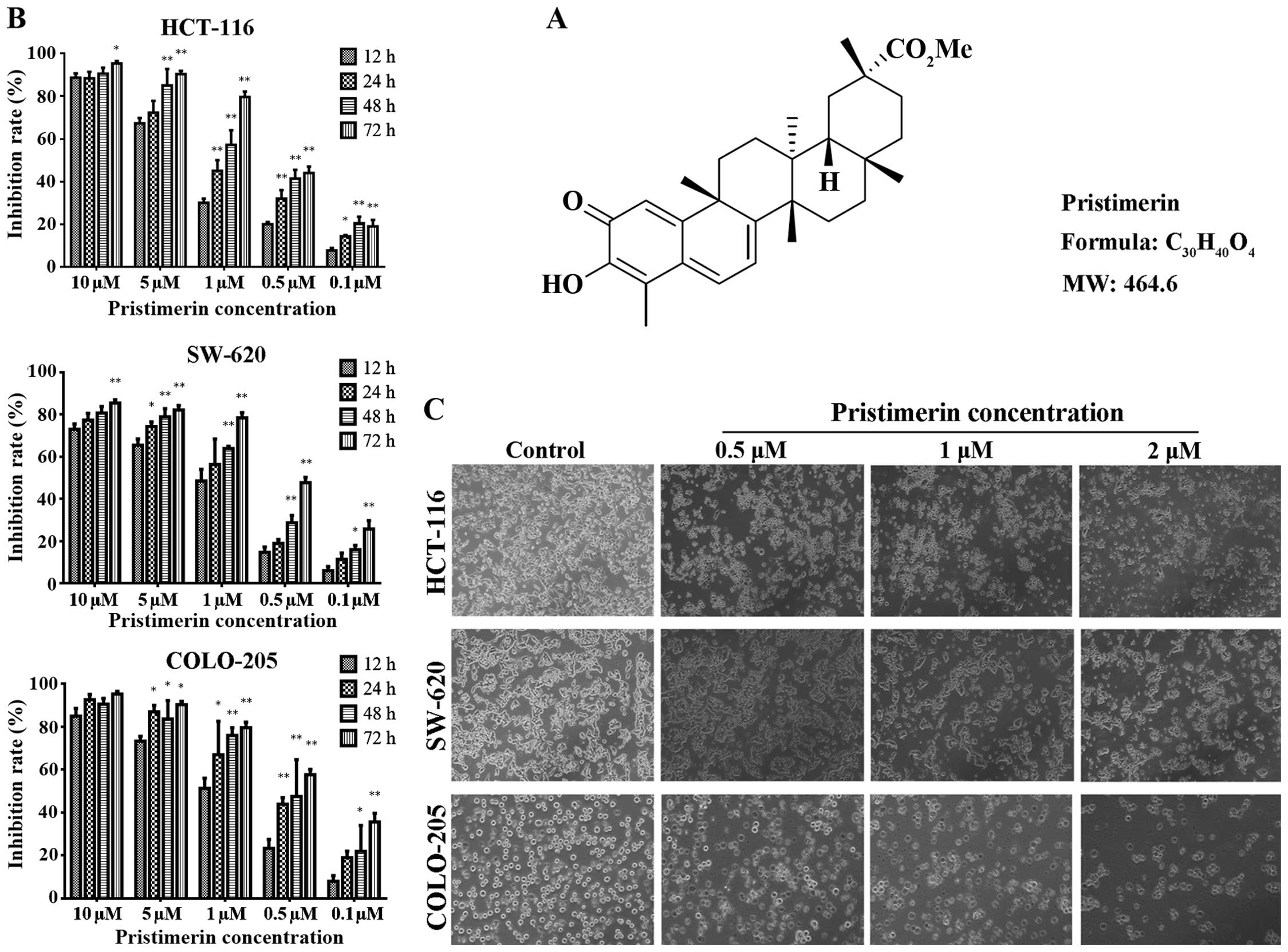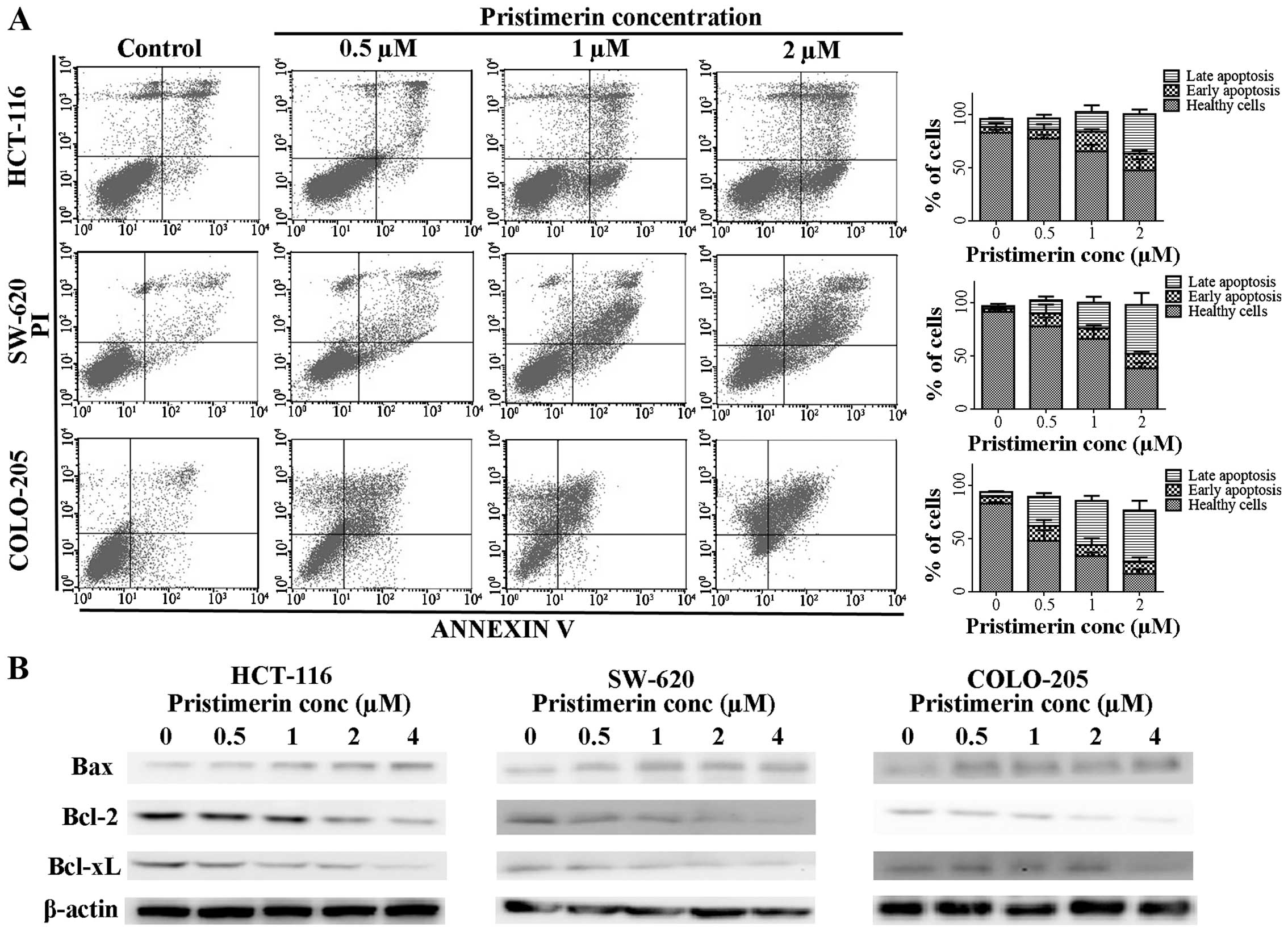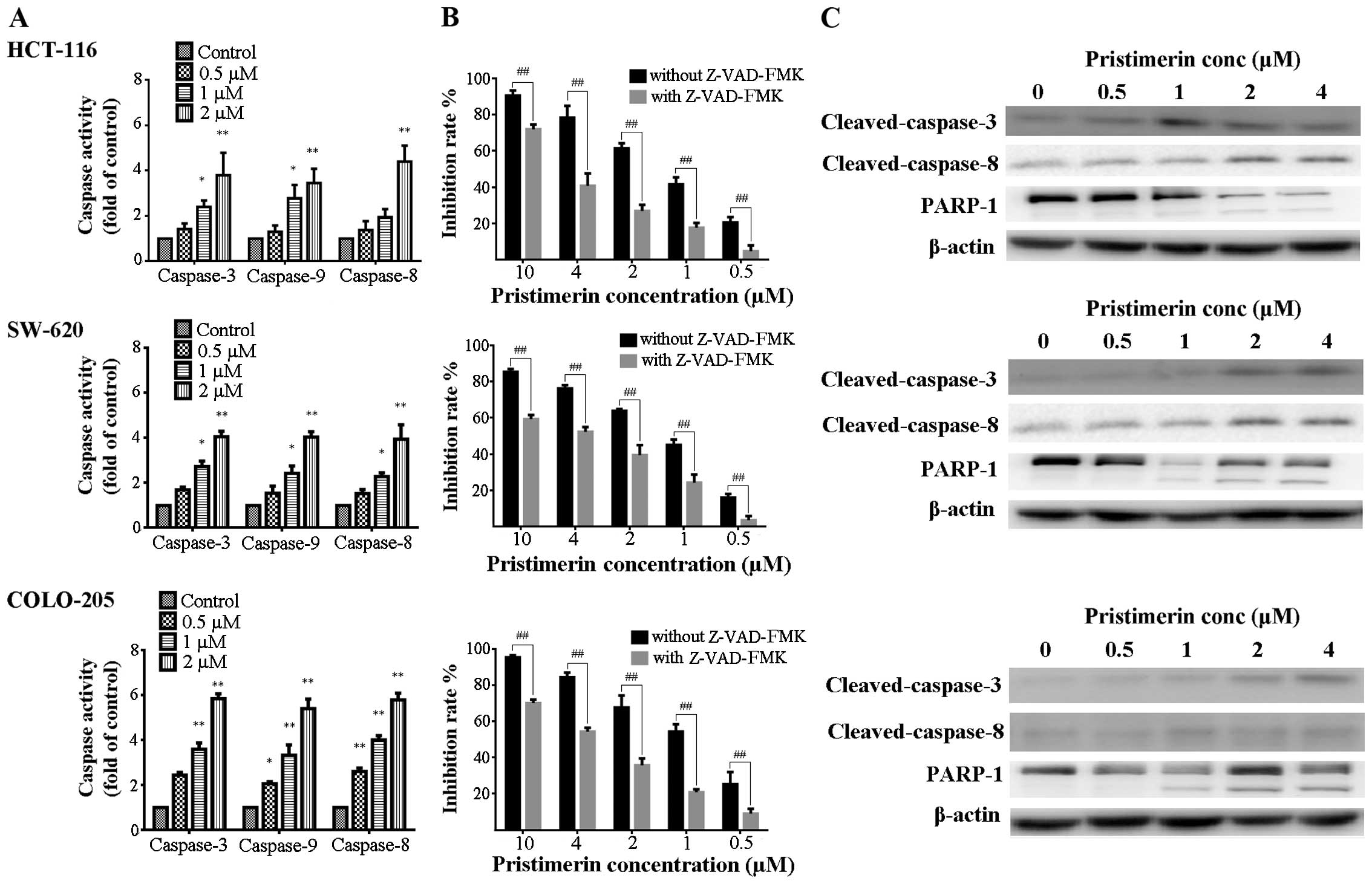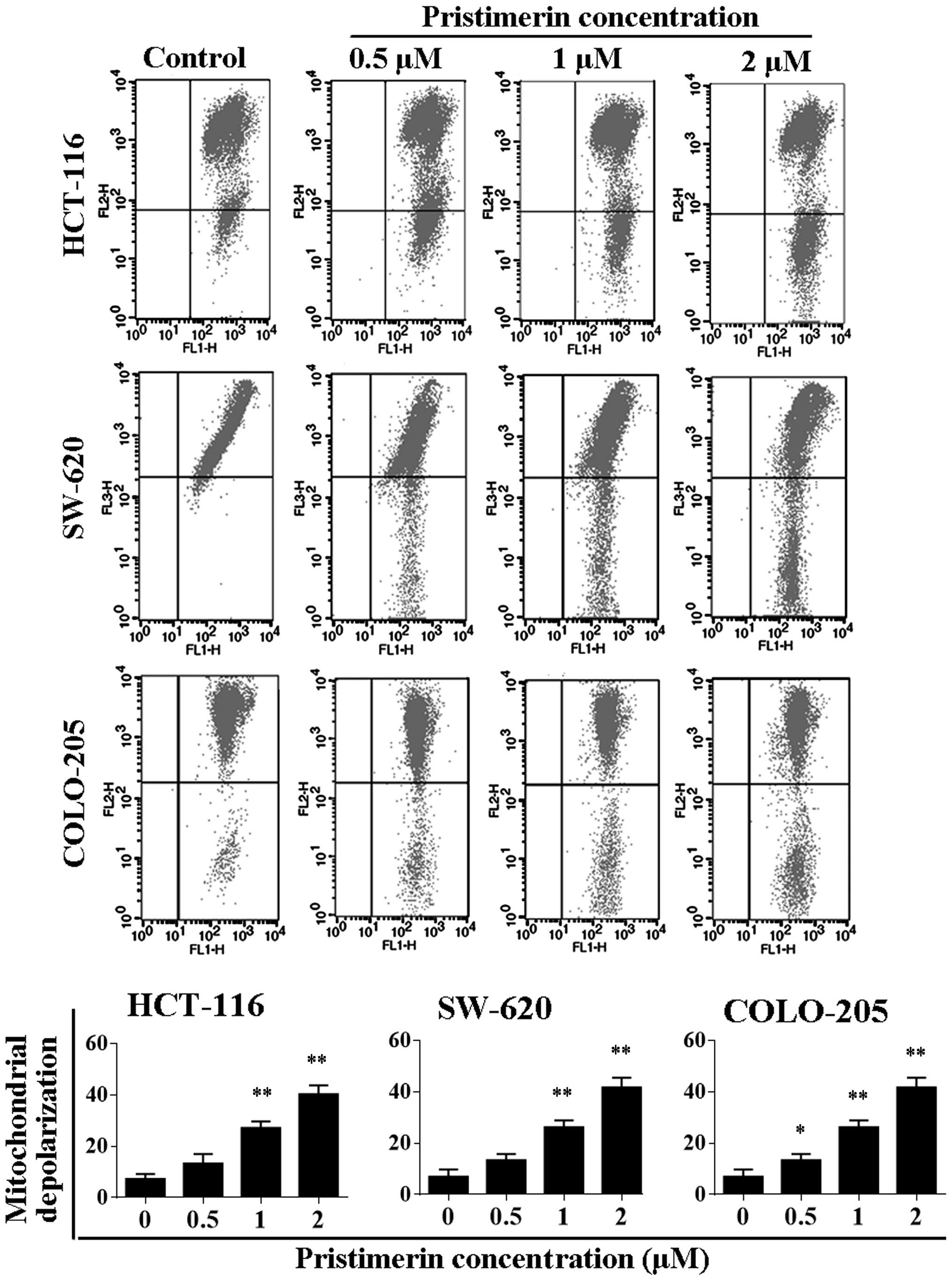Introduction
Colorectal cancer (CRC) is the third most common
cancer worldwide, with more than 1 million new cases diagnosed each
year (1). CRC is the fourth most
common cause of cancer-related mortality worldwide (1), and the third most common cause of
cancer-related mortality in the US (2). CRC is a heterogeneous disease with
different molecular characteristics such as abnormal genetic and
epigenetic alterations in several signaling pathways which are
responsible for controlling cell proliferation, apoptosis and
invasion of CRC (3,4). The management of CRC has improved in
the last decade, in term of screening, surgical management and
adjuvant chemotherapy.
Natural compounds have become important in
anticancer drug development as they are more tolerable to the human
body (5). Pristimerin (Fig. 1A) is a naturally occurring
quinonemethide triterpenoid compound isolated from the
Celastraceae and Hippocrateaceae families.
Pristimerin has long been used as an anti-inflammatory,
antioxidant, antimalarial and insecticidal agent (6,7). It
also has promising clinical potential as both a chemotherapeutic
and chemopreventive agent for cancer. Indeed, it has been reported
to exhibit a cytotoxic effect on several human cancer cell lines
including breast (8), pancreatic
(9), hepatic (10), cervical (11) and prostate cancer (12), and glioma tumor cells (13). However, the exact mechanism of
pristimerin cytotoxicity has not been completely explored.
Furthermore, pristimerin has been reported to induce cancer cell
death via different mechanisms of action, including the
caspase-dependent apoptotic cascade (8), potent proteasomal inhibition (14), suppression of nuclear factor-κB
(NF-κB) activity (15), and
oxidative stress induction (11).
Although pristimerin has a variety of reported
antitumor activities, its effect on colon cancer cell lines and the
underlying mechanism of action have never been explored. In the
present study, we examined the effect of pristimerin on three human
colon cancer cell lines namely HCT-116, SW-620 and COLO-205. Our
results revealed that pristimerin strongly suppressed the growth of
these cell lines by inducing G1 phase cell cycle arrest and
apoptosis. Furthermore, the anticancer effects of pristimerin were
associated with inhibition of EGFR and HER2 and related downstream
signaling pathways.
Materials and methods
Materials
Pristimerin with a purity of >97% was purchased
from Enzo Life Sciences (Lausen, Switzerland).
3-(4,5-Dimethylthiazol-2-yl)-2,5-diphenyltetrazolium bromide (MTT)
was purchased from Sigma (St. Louis, MO, USA). Annexin V-FITC
apoptosis detection kit was purchased from BD Pharmingen (San
Diego, CA, USA). Cell cycle assay kit, caspase-3, -8 and -9
activity assay kits and mitochondrial membrane potential (ΔΨm)
assay kit were purchased from Beyotime Institute of Biotechnology
(Nanjing, China). Antibodies against cleaved caspase-3, cleaved
caspase-8, Bcl-2, Bcl-xL, Bax, PARP-1, HER2, p-HER2, p-EGFR, mTOR,
p-mTOR, cyclin D1, Cdk-4, cdk-6, Rb and p-Rb were obtained from
Cell Signaling Technology (Danvers, MA, USA). Antibodies against
ERK1/2, p-ERK1/2, Akt, p-Akt, NF-κB P65 and p-NF-κB P65 were
purchased from Santa Cruz Biotechnology (Santa Cruz, CA, USA). The
antibody against EGFR was purchased from Abcam (Cambridge, UK);
both anti-mouse IgG-horseradish peroxidase, anti-goat
IgG-horseradish peroxidase and anti-rabbit IgG-horseradish
peroxidase were purchased from KangChen Biotechnology (Shanghai,
China).
Cell lines and cell culture
The human colon cancer cell lines HCT-116, SW-620
and COLO-205 were obtained from the American Type Culture
Collection (ATCC; Manassas, VA, USA). The HCT-116 and COLO-205
cells were cultured in RPMI-1640 medium (HyClone China Ltd.,
China), supplemented with 10% fetal bovine serum (FBS; Gibco-BRL,
Grand Island, NY, USA), penicillin (100 U/ml) and streptomycin (100
µg/ml) (Sigma) and maintained at 37°C in a humidified
atmosphere containing 5% CO2. SW-620 cells were cultured
in Leibovitz's L-15 medium (HyClone China Ltd.), supplemented with
10% FBS, penicillin (100 U/ml) and streptomycin (100 µg/ml)
at 37°C under a humidified 100% atmosphere.
Cell viability assay
The inhibitory effect of pristimerin on cell
viability was measured by MTT method. Briefly, 5×103
cells/well were seeded into 96-well plates for 24 h, and then the
medium was replaced with fresh medium containing various
concentrations of pristimerin (0, 0.1, 0.5, 1, 5 and 10 µM)
for 12, 24, 48 and 72 h. After incubation, MTT was added to each
well at a final concentration of 0.5 mg/ml. The insoluble formazan
was collected and dissolved in dimethylsulfoxide (DMSO) and
measured with a microplate reader (Safire2; Tecan,
Switzerland) at 540 nm.
DNA cell cycle analysis
Cells were treated with various pristimerin
concentrations (0, 0.5, 1 and 2 µM) in complete medium for
48 h. Both floating and adherent cells were harvested by
centrifugation (3,000 x g for 5 min), washed twice with ice-cold
phosphate-buffered saline (PBS) and fixed in ice-cold 75% ethanol
at 4°C overnight. The ethanol was subsequently removed after
centrifugation, and ~1×106 cells were re-suspended in
PBS containing 25 µg/ml RNase. Samples were then incubated
with propidium iodide (PI) (50 µg/ml) at 37°C for 30 min and
were analyzed by a flow cytometer (Becton-Dickinson, San Jose, CA,
USA).
Annexin V/PI double-staining assay
Apoptosis was measured by a flow cytometer using
Annexin V/PI double staining. HCT-116, SW-620 and COLO-205 cells
were cultured in a 60-mm dish at a density of
2×105/dish. On the following day, the cells were treated
with pristimerin (0, 0.5, 1 and 2 µM). After 48 h, the cells
were harvested, both floating and attached cells were collected,
washed with ice-cold PBS twice, and re-suspended in 200 µl
binding buffer containing Annexin V and 40 ng/sample PI for 15 min
at 37°C in the dark (according to the manufacturer's instructions).
The number of viable, apoptotic and necrotic cells was then
quantified by a flow cytometer.
Analysis of caspase-3, -8 and -9
activities
Caspase-3, -8 and -9 activities were measured using
colometric assay kits as previously described (16) and following the manufacturer's
guideline. Briefly, HCT-116, SW-620 and COLO-205 cells without or
with (0.5, 1 and 2 µM) pristimerin treatment, were washed
with cold PBS, re-suspended in lysis buffer and left on ice for 15
min. The lysate was centrifuged at 16,000 x g at 4°C for 15 min.
Activities of caspase-3, -8 and -9 were measured using substrate
peptides Ac-DEVD-pNA, Ac-IETD-pNA and Ac-LEHD-pNA, respectively.
Release of p-nitroanilide (pNA) was qualified by determining the
absorbance with a spectrophotometer. Data were normalized against
the control untreated cells.
Pan-caspase inhibitor Z-VAD-FMK
HCT-116, SW-620 and COLO-205 cells were seeded into
96-well plates at an initial density of 5×103
cells/well. After 24 h, the cells were pre-incubated with 50
µM Z-VAD-FMK (Beyotime Institute of Biotechnology) for 1 h
and then incubated with pristimerin (0, 0.5, 1, 2, 4 and 10
µM) for 48 h. The inhibition rate (%) was measured by MTT in
both the presence and absence of Z-VAD-FMK.
ΔΨm assay
The JC-1 probe was used to measure mitochondrial
depolarization in HCT-116, SW-620 and COLO-205 cells. Briefly, the
cells were cultured into 6-well plates; after treatment with
pristimerin (0, 0.5, 1 and 2 µM) for 48 h, they were
incubated with an equal volume of a JC-1 staining solution (5
µg/ml) at 37°C for 20 min and rinsed twice with PBS. Changes
in ΔΨm were analyzed using a flow cytometer with the excitation and
emission wavelengths of 488 and 525 nm, respectively.
Whole-cell lysates and western blot
analysis
HCT-116, SW-620 and COLO-205 cells were collected
following treatment and lysed by lysis buffer (KangChen
Biotechnology) for 30 min on ice. Cell lysates were centrifuged at
12,000 rpm for 15 min at 4°C. Total protein concentration in the
supernatants was detected by a bicinchoninic acid (BCA) protein
assay kit (Beyotime Institute of Biotechnology). Equal amounts of
lysate proteins were separated on 8–12% SDS-PAGE and transferred
onto nitrocellulose membranes. The non-specific binding sites were
blocked with TBST buffer containing 5% free-fat milk for 2 h.
Following overnight incubation at 4°C with specific primary
antibodies, the membranes were washed three times with TBST buffer
and incubated at room temperature for 1 h with horseradish
peroxidase-conjugated secondary antibody. After three washes with
TBST buffer, the immunoblots were visualized using the enhanced
chemiluminescence (ECL; Millipore Corporation) detection kit.
Immunoreactive bands were scanned (GS-800) and analyzed using a
ChemiDoc XRS imaging system (Quantity One, v4.4.0) (both from
Bio-Rad Life Sciences, Hercules, CA, USA).
Statistical analysis
Data were analyzed using GraphPad Prism 6 (GraphPad
Software, Inc., San Diego, CA, USA). All data are expressed as mean
± standard deviation (SD) from at least three independent
experiments. The statistical comparisons between the control and
treatment groups were determined using the Student's two-tailed
t-test. Differences with p<0.05 were considered statistically
significant.
Results
Pristimerin exerts potent cytotoxicity
against colon cancer cells
Pristimerin cytotoxicity in colon cancer cells was
assessed by MTT assay. As shown in Fig.
1B, pristimerin treatment caused a dose- and time-dependent
inhibition of cell growth in all three tested colon cancer cell
lines. Following 48 h of treatment, the IC50 values of
pristimerin in the HCT-116, SW-620 and COLO-205 cells were
1.22±0.25, 1.04±0.17 and 0.84±0.14 µM, respectively.
Next, we focused on the effect of pristimerin on
colon cancer cell morphology. Untreated HCT-116, SW-620 and
COLO-205 cells appeared healthy with clear skeletons, whereas the
pristimerin-treated HCT-116 and SW-620 cells were detached and
distorted and certain cells became rounded and floated (Fig. 1C). COLO-205 cells treated with
pristimerin were distorted with an unclear cytoplasm and skeleton
(Fig. 1C). These changes occurred
in a dose-dependent manner. Taken together, the MTT assay and
morphological data indicated that pristimerin has potent cytotoxic
effects on colon cancer cells.
Pristimerin induces G1 phase arrest and
modulates cell cycle-related proteins in colon cancer cells
The effect of pristimerin on the cell cycle was
examined by flow cytometric analysis of cellular DNA content.
HCT-116, SW-620 and COLO-205 cells were treated with pristimerin
for 48 h. As shown in Fig. 2A,
pristimerin caused cell cycle transition arrest in the G0/G1 phase
and the proportion of cells in the G0/G1 phase was markedly
increased in a concentration-dependent manner. G1 phase cell cycle
distribution was 61.2, 74.5, 86.9 and 90% (HCT-116); 70.5, 81.3,
87.9 and 91.2% (SW-620); 65.8, 74.5, 86.1 and 90.4% (COLO-205) when
the cells were treated with pristimerin at 0, 0.5, 1 and 2
µM, respectively. The increments in the G0/G1 phases were
accompanied by concomitant reduction in the proportion of cells in
the S and G2/M phases of the cell cycle in the CRC cell lines, with
the presence of a small proportion of sub-G1 cells at higher
concentrations, which indicated apoptosis. Taken together, these
findings suggest that pristimerin-induced G1 arrest in colon cancer
cells may be responsible for its growth inhibitory effects.
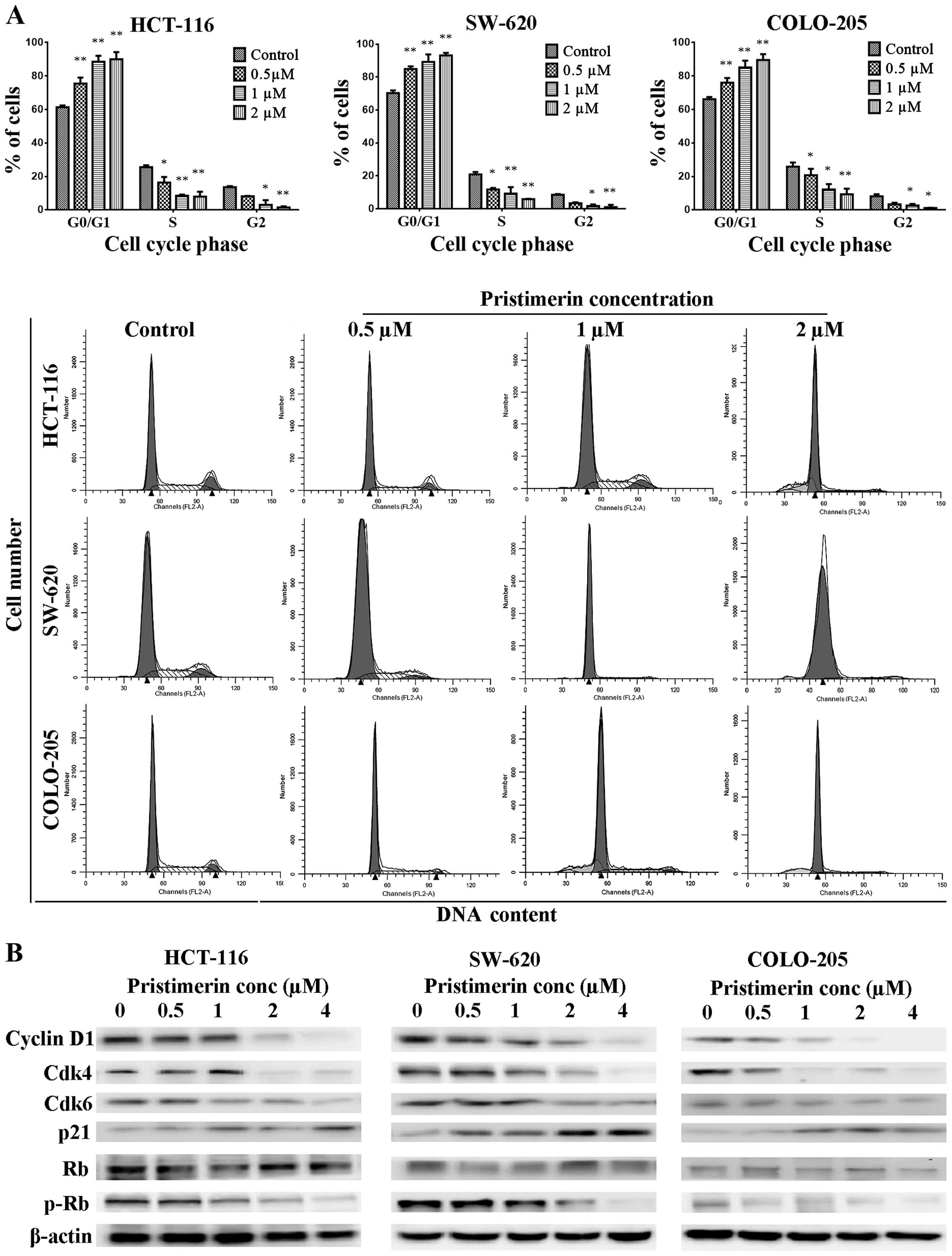 | Figure 2Pristimerin-induced cell cycle
arrest. (A) The effects of pristimerin on cell cycle distribution
are shown. HCT-116, SW-620 and COLO-205 cells were treated either
with pristimerin (0.5, 1 and 2 µM) or DMSO (control) for 48
h, and the cells were collected, stained and analyzed for the
percentage of cells in different phases of the cell cycle.
*p<0.05, **p<0.01 vs. the control. (B)
The effects of pristimerin on cell cycle-associated protein
expression in the HCT-116, SW-620 and COLO-205 cells which were
treated either with pristimerin (0.5, 1, 2 and 4 µM) or DMSO
(control) for 48 h. Total cell lysates were analyzed by western
blot analysis (three independent experiments) for G1 cell cycle
regulatory proteins (cyclin D1, cdk4, cdk6, p21, Rb and p-Rb).
β-actin was used as the control. |
To understand the mechanism behind
pristimerin-induced G1 phase arrest, we investigated the effect of
pristimerin on levels of proteins that regulate the progression of
cells in the G1 phase including p21, cyclin D1, cdk4, cdk6,
retinoblastoma (Rb) and p-Rb. As shown in Fig. 2B, the protein level of cyclin D1 was
significantly decreased by pristimerin in a concentration-dependent
manner in all three colon cancer cell lines. Similarly, a
dose-dependent reduction in the expression levels of cdk4 and cdk6
were observed (Fig. 2B). In
addition, pristimerin decreased the p-Rb level in a dose-dependent
manner without change in total Rb protein levels. Furthermore,
exposure to pristimerin generated a dose-dependent induction of p21
expression in all three colon cancer cell lines (Fig. 2B). We assumed that the pristimerin
modulation of cell cycle regulatory proteins may have contributed
to the pristimerin-mediated G1 phase arrest in the colon cancer
cells.
Pristimerin-induced apoptosis in the
colon cancer cells
Pristimerin-induced apoptosis was also studied in
colon cancer cells. Cells were treated with varying pristimerin
concentrations for 48 h, stained with Annexin V/PI, and subjected
to analysis using a flow cytometer. As shown in Fig. 3A, pristimerin treatment of colon
cancer cells provoked significant dose-dependent enhancement in
both early and late stages of apoptosis. The apoptotic indices were
11.5, 21.4, 39.9 and 55.8% (HCT-116); and 5.7, 23.4, 36.1 and 64.5%
(SW-620); and 11, 35.2, 62.7 and 72.1% (COLO-205) at 0, 0.5, 1 and
2 µM concentrations of pristimerin, respectively (Fig. 3A).
To explore how pristimerin induced apoptosis, we
studied the action of pristimerin on Bcl-2 family proteins, which
play an important role in the regulation of apoptosis, including
pro-apoptotic proteins (Bax) and anti-apoptotic proteins (Bcl-2 and
Bcl-xL). Western blot analysis showed that pristimerin treatments
resulted in a dose-dependent reduction in the levels of
anti-apoptotic proteins Bcl-2 and Bcl-xL (Fig. 3B). In contrast, the level of
pro-apoptotic protein Bax was significantly increased upon
treatment with pristimerin in a dose-dependent manner (Fig. 3B). Thus, pristimerin treatment
modulated the Bcl-2 family protein levels in a manner that led to
increased ratios of Bax/Bcl-2 and Bax/Bcl-xL, which may have
contributed to the observed apoptotic effect of pristimerin.
To further understand the effects of pristimerin on
cell apoptosis, we studied its effects on caspase-3, -8 and -9
activities and PARP-1 activation. Pristimerin treatment caused a
dose-dependent enhancement in caspase-3, -8 and -9 activities in
all the tested cell lines compared with these levels in the control
after 48 h of treatment (Fig. 4A).
Pretreatment of cells for 1 h with 50 µl of Z-VAD-FMK, a
pan-caspase inhibitor caused a significant reduction in pristimerin
cytotoxicity in the colon cancer cells (Fig. 4B). Subsequently, we studied the
expression of cleaved caspase-3 and -8, and PARP-1 in all three
tested cell lines by western blotting. Pristimerin treatment also
increased the expression of cleaved caspase-3 and -8, with
increased cleavage of PARP-1 in a concentration-dependent manner
(Fig. 4C). Taken together,
pristimerin induced caspase-dependent apoptotic cell death in the
colon cancer cells.
Pristimerin-induced loss of Δψm
Since the intrinsic apoptotic pathway is
predominantly triggered by changes in Δψm, we further investigated
the theory that pristimerin treatment-induced mitochondrial
apoptosis was due to the changes in Δψm. HCT-116, SW-620 and
COLO-205 cells treated with pristimerin (0.5, 1 and 2 µM)
for 48 h were loaded with ΔΨm JC-1 probe, and the fluorescent shift
in cells was measured by a flow cytometer. There was a significant
change in mitochondrial potential after pristimerin treatment as
shown in Fig. 5; pristimerin
induced mitochondrial depolerization in a dose-dependent
manner.
Pristimerin inhibits EGFR, HER2
activation and related signaling pathways in colon cancer
cells
To understand the molecular basis of
pristimerin-mediated anticancer activity, we examined the effect of
pristimerin on EGFR and HER2 receptors, which are overexpressed in
colon cancer (17). In the present
study, we demonstrated that pristimerin exhibited anticancer
activity against HCT-116 (EGFR strong), COLO-205 (EGFR weak) and
SW-620 (EGFR negative), while all three cell lines showed
detectable HER2 levels. Our results showed that pristimerin
inhibited EGFR phosphorylation in a dose-dependent manner in the
HCT-116 and COLO-205 cells, and inhibited HER2 phosphorylation in
the three tested cell lines in a dose-dependent manner, with
insignificant change in total EGFR and HER-2 protein expression
(Fig. 6). Next, we evaluated
whether the pristimerin-dependent reduction in EGFR and HER2
activities was associated with reduced downstream kinase activity
including mitogen-activated protein kinase (MAPK),
phosphatidylinositol 3-kinase (PI3K)/Akt/mTOR and NF-κB signaling
pathways (18). We found that
pristimerin significantly suppressed phosphorylation of ERK1/2,
Akt, mTOR and NF-κB in a dose-dependent manner (Fig. 6), with no effect on total protein
expression. The results suggest that pristimerin exerts its
anticancer effects through both inhibition of EGFR and HER-2
activation on colon cancer cell surfaces and suppression of
downstream ERK1/2, Akt, mTOR and NF-κB signaling pathways.
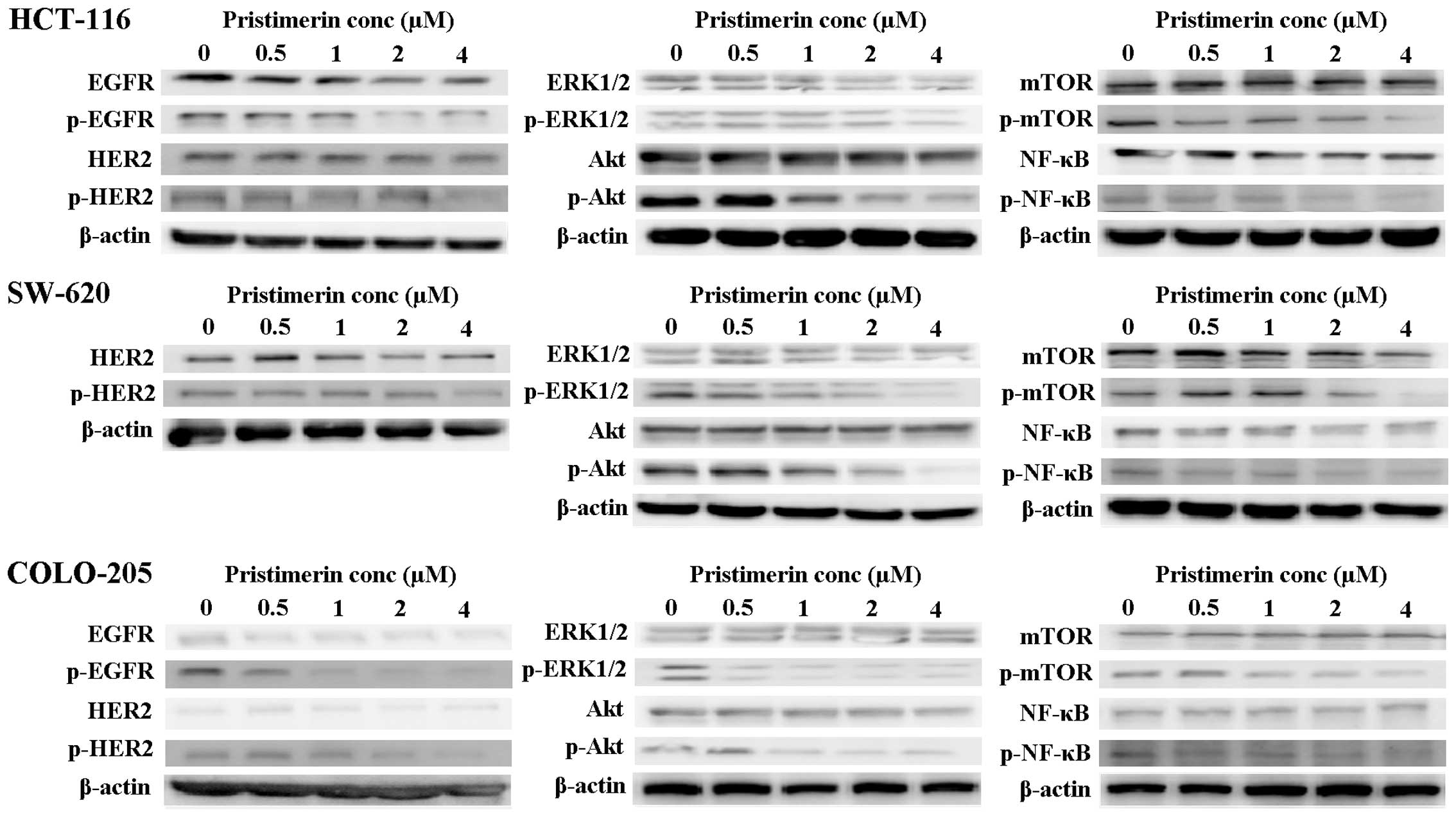 | Figure 6Pristimerin inhibited EGFR, HER2 and
related downstream signaling proteins in colon cancer cells.
HCT-116, SW-620 and COLO-205 cells were treated either with
pristimerin (0.5, 1 and 2 µM) or DMSO (control) for 48 h.
Total cell lysates were analyzed by western blot analysis (three
independent experiments) for EFGR, p-EGFR, HER2 and p-HER2. In
addition, downstream targets (ERK1/2, p-ERK1/2, Akt, p-Akt, mTOR,
p-mTOR, NF-κB and p-NF-κB) also were detected. β-actin was used as
control. |
Discussion
Plants are important sources of biologically active
natural products which have become more important in anticancer
drug development as they are more tolerable to the human body
(5). Pristimerin is a natural
triterpenoid that has been shown to possess a variety of biological
activities. It has been reported to exhibit anticancer activity
against different human cancer cells (19). In the present study, we examined the
pristimerin cytotoxicity against three colon cancer cell lines for
the first time. Our experimental results showed that pristimerin
displayed dose- and time-dependent potent cytotoxicity in colon
cancer cells. The cytotoxic effects were further confirmed by
studied morphological changes induced by pristimerin on human colon
cancer cells.
Persistence of cell cycle progression in cancer
cells is regarded as one of the hallmarks of cancer (20). Therefore, it is considered as a
target for the treatment of human malignancies (21). Pristimerin was found to induce cell
cycle arrest in a variety of human cancer cell lines, including
pancreatic cancer (9) and myeloma
tumors (15). Our results revealed
that pristimerin treatment of colon cancer cells induced a
dose-dependent arrest of cells in the G1 phase. Cell cycle
progression is highly controlled by many processes involved in
activation of cyclin-dependent kinases (CDKs), which are paired
with the cyclins (e.g. cyclins A, B, E, D1-3) (22). Activation of CDKs by cyclins leads
to phosphorylation of Rb and leads to diminished binding of Rb to
the E2F transcription factor, which enhances transcription of
various genes necessary for cell cycle progression (23). The activities of CDKs are
antagonized by CDK inhibitors, such as p27 and p21, which directly
interact with CDKs (24). In order
to investigate the mechanism underlying pristimerin-induced G1
phase cell cycle arrest, cell cycle regulatory proteins, CDKs and
CDK inhibitors were analyzed using western blot analysis. Our
results showed that pristimerin upregulated p21 expression, along
with decreased cyclin D1, Cdk-4 and Cdk-6 expression. In addition,
pristimerin decreased phosphorylated Rb expression, which led to G1
phase arrest. These findings suggest that pristimerin-induced G1
phase cell cycle arrest may be mediated through the cyclin-CDK
checkpoint.
Apoptotic resistance is another important hallmark
of cancer cells (20). Thus,
activation of apoptotic pathways is a key mechanism by which
anticancer drugs kill tumor cells (25). Apoptosis is a highly regulated and
organized cell death process. Two major pathways of apoptosis,
depending on different apoptotic stimuli, are the mitochondrial
pathway (intrinsic) and the death receptor pathway (extrinsic)
(26). In the present study, we
observed that pristimerin induced apoptotic cell death in a
dose-dependent manner, which was confirmed by Annexin V/PI double
staining, confirming membrane alterations related to apoptosis in
colon cancer cells. Moreover, our caspase activity assay showed
that pristimerin was able to induce caspase-dependent apoptosis in
human colon cancer cells in a dose-dependent manner. This
caspase-dependent apoptosis was further explored by the presence of
pan-caspase inhibitor (Z-VAD-FMK), which reduced the cytotoxic
activity of pristimerin. We found that pristimerin induced
apoptosis via the cell death receptor pathway (extrinsic) by
activating caspase-8 and -3. These results were in line with a
previous study on human breast cancer cells (27). Furthermore, pristimerin showed
activation of caspase-9 and -3, which are modulators of the
mitochondrial pathway (intrinsic) (28). The activation of caspases are
crucial steps in apoptotic cell death, which consequently induce
PARP-1 cleavage, another marker of cell apoptosis (29).
Mitochondria have been shown to play a central role
in the apoptotic process, through both intrinsic and extrinsic
pathways. Mitochondrial membrane permeability is one of the most
important features of the mitochondria, and permeability change,
mainly through permeability transition pores, leads to
pro-apoptotic factor release, loss of mitochondrial membrane
potential (Δψm) and cell death (30). Our results showed that pristimerin
induced conformational changes of mitochondria, followed by
redistribution of pro-apoptotic factors and ΔΨm loss in a
dose-dependent manner. Bcl-2, Bcl-xL and Bax have been implicated
as major regulators of the role of mitochondrial in apoptosis
(31). Pro-apoptotic Bcl-2 members
bind to the mitochondrial outer membrane and block cytochrome
c efflux. In apoptosis, Bax translocates from the cytosol to
the mitochondria where it increases the efflux of cytochrome
c through the mitochondrial outer membrane (32). Thus, changes in anti-apoptotic and
pro-apoptotic Bcl-2 family proteins are critical for the induction
of apoptosis (33). Pristimerin
treatment of colon cancer cells increased Bax protein expression
and decreased both Bcl-2 and Bcl-xL expression thereby increasing
the Bax/Bcl-2 and Bax/Bcl-xL ratios leading to apoptosis.
Collectively, our results revealed that pristimerin induced both
intrinsic and extrinsic apoptotic pathways in the colon cancer cell
lines.
Overexpression of growth factors and their receptors
(EGFR and HER2) play a vital role in the tumorigenesis of
colorectal carcinoma, which leads to constitutive activation of
tyrosine kinase activity of EGFR and related downstream signaling
pathways (17,34). Therefore, agents that target EGFR
and/or HER2 receptor show anticancer activity against CRC (35). Our results showed that the tested
colon cancer cell lines had different expression patterns of growth
factor receptors, as previously reported (36). Pristimerin inhibited EGFR and HER2
activation in a dose-dependent manner. The same results were
previously reported in glioma tumors (13) and breast cancer cells (27). Upregulation and activation of EGFR
and HER-2 were found to lead to the activation of multiple
intracellular signaling cascades that are responsible for
tumorigenesis of colon cancer including MAPK, PI3K/Akt/m-TOR and
NF-κB signaling pathways (18,37).
The downstream MAPK/ERK signaling pathway plays an important role
in cell proliferation and apoptosis regulation (38). Our results showed that pristimerin
blocked ERK1/2 phosphorylation. The same results were obtained in
hepatic (10) and breast cancer
cells (39). PI3K/AKT is another
downstream signaling pathway of EFGR/HER2 that controls cell
proliferation, survival, apoptosis and malignant transformation
(40). Our results illustrated that
pristimerin reduced Akt activation as a consequence of EFGR/HER2
inhibition. Anti-apoptotic/pro-survival NF-κB and mTOR signaling
pathways are downstream targets of activated PI3K/AKT, which
controls cell growth, survival, division and motility (41,42).
Pristimerin also blocked both phosphorylation and activation of
these pathways. Other researchers found the same results, in which
pristimerin inhibited pro-survival Akt/NF-κB/m-TOR signaling
proteins in pancreatic cancer cells (43). Pristimerin inhibited the expression
of p-ERK, p-Akt, p-NF-κB and p-mTOR in colon cancer cells, which
indicated that inhibition of those pro-survival signaling proteins
was essential for pristimerin-induced apoptosis.
In conclusion, our findings revealed that
pristimerin induced cell cycle arrest and apoptosis in human colon
cancer cells HCT-116, SW-620 and COLO-205 through cyclin-CDK,
mitochondrial dysfunction and caspase-dependent mechanisms. The
mechanisms may involve inhibi tion of phosphorylated EGFR and HER2
expression, and subsequently caused inhibition of related
downstream kinases. These findings suggest that pristimerin may be
a novel candidate for colon cancer therapy.
Acknowledgments
The present study was funded by the Priority
Academic Program Development of Jiangsu Higher Education
Institutions (PAPD), also supported by the fundamental research
funds for the central universities (YD2014SK0002). The present
study was also partially supported by the 111 Project (111-2-07),
and the National 12th Five-Year Plan: The 'Major Scientific and
Technological Special Project for Significant New Drug Creation'
Project (no. 2012ZX09504001-001).
References
|
1
|
Tenesa A and Dunlop MG: New insights into
the aetiology of colorectal cancer from genome-wide association
studies. Nat Rev Genet. 10:353–358. 2009. View Article : Google Scholar : PubMed/NCBI
|
|
2
|
Siegel R, Ma J, Zou Z and Jemal A: Cancer
statistics, 2014. CA Cancer J Clin. 64:9–29. 2014. View Article : Google Scholar : PubMed/NCBI
|
|
3
|
Wood LD, Parsons DW, Jones S, Lin J,
Sjöblom T, Leary RJ, Shen D, Boca SM, Barber T, Ptak J, et al: The
genomic landscapes of human breast and colorectal cancers. Science.
318:1108–1113. 2007. View Article : Google Scholar : PubMed/NCBI
|
|
4
|
Cancer Genome Atlas Network: Comprehensive
molecular characterization of human colon and rectal cancer.
Nature. 487:330–337. 2012. View Article : Google Scholar : PubMed/NCBI
|
|
5
|
Newman DJ, Cragg GM and Snader KM: Natural
products as sources of new drugs over the period 1981–2002. J Nat
Prod. 66:1022–1037. 2003. View Article : Google Scholar : PubMed/NCBI
|
|
6
|
Brinker AM, Ma J, Lipsky PE and Raskin I:
Medicinal chemistry and pharmacology of genus Tripterygium
(Celastraceae). Phytochemistry. 68:732–766. 2007. View Article : Google Scholar : PubMed/NCBI
|
|
7
|
Dirsch VM, Kiemer AK, Wagner H and Vollmar
AM: The triterpenoid quinonemethide pristimerin inhibits induction
of inducible nitric oxide synthase in murine macrophages. Eur J
Pharmacol. 336:211–217. 1997. View Article : Google Scholar
|
|
8
|
Wu CC, Chan ML, Chen WY, Tsai CY, Chang FR
and Wu YC: Pristimerin induces caspase-dependent apoptosis in
MDA-MB-231 cells via direct effects on mitochondria. Mol Cancer
Ther. 4:1277–1285. 2005. View Article : Google Scholar : PubMed/NCBI
|
|
9
|
Wang Y, Zhou Y, Zhou H, Jia G, Liu J, Han
B, Cheng Z, Jiang H, Pan S and Sun B: Pristimerin causes G1 arrest,
induces apoptosis, and enhances the chemosensitivity to gemcitabine
in pancreatic cancer cells. PLoS One. 7:e438262012. View Article : Google Scholar : PubMed/NCBI
|
|
10
|
Guo Y, Zhang W, Yan YY, Ma CG, Wang X,
Wang C and Zhao JL: Triterpenoid pristimerin induced HepG2 cells
apoptosis through ROS-mediated mitochondrial dysfunction. J BUON.
18:477–485. 2013.PubMed/NCBI
|
|
11
|
Byun JY, Kim MJ, Eum DY, Yoon CH, Seo WD,
Park KH, Hyun JW, Lee YS, Lee JS, Yoon MY, et al: Reactive oxygen
species-dependent activation of Bax and poly(ADP-ribose)
polymerase-1 is required for mitochondrial cell death induced by
triterpenoid pristimerin in human cervical cancer cells. Mol
Pharmacol. 76:734–744. 2009. View Article : Google Scholar : PubMed/NCBI
|
|
12
|
Liu YB, Gao X, Deeb D, Brigolin C, Zhang
Y, Shaw J, Pindolia K and Gautam SC: Ubiquitin-proteasomal
degradation of antiapoptotic survivin facilitates induction of
apoptosis in prostate cancer cells by pristimerin. Int J Oncol.
45:1735–1741. 2014.PubMed/NCBI
|
|
13
|
Yan YY, Bai JP, Xie Y, Yu JZ and Ma CG:
The triterpenoid pristimerin induces U87 glioma cell apoptosis
through reactive oxygen species-mediated mitochondrial dysfunction.
Oncol Lett. 5:242–248. 2013.
|
|
14
|
Yang H, Landis-Piwowar KR, Lu D, Yuan P,
Li L, Reddy GP, Yuan X and Dou QP: Pristimerin induces apoptosis by
targeting the proteasome in prostate cancer cells. J Cell Biochem.
103:234–244. 2008. View Article : Google Scholar
|
|
15
|
Tiedemann RE, Schmidt J, Keats JJ, Shi CX,
Zhu YX, Palmer SE, Mao X, Schimmer AD and Stewart AK:
Identification of a potent natural triterpenoid inhibitor of
proteosome chymotrypsin-like activity and NF-kappaB with
antimyeloma activity in vitro and in vivo. Blood. 113:4027–4037.
2009. View Article : Google Scholar
|
|
16
|
Liu C, Yu K, Shi X, Wang J, Lam PK, Wu RS
and Zhou B: Induction of oxidative stress and apoptosis by PFOS and
PFOA in primary cultured hepatocytes of freshwater tilapia
(Oreochromis niloticus). Aquat Toxicol. 82:135–143. 2007.
View Article : Google Scholar : PubMed/NCBI
|
|
17
|
Milano G, Etienne-Grimaldi MC, Dahan L,
Francoual M, Spano JP, Benchimol D, Chazal M, Letoublon C, André T,
Gilly FN, et al: Epidermal growth factor receptor (EGFR) status and
K-Ras mutations in colorectal cancer. Ann Oncol. 19:2033–2038.
2008. View Article : Google Scholar : PubMed/NCBI
|
|
18
|
Spano JP, Fagard R, Soria JC, Rixe O,
Khayat D and Milano G: Epidermal growth factor receptor signaling
in colorectal cancer: Preclinical data and therapeutic
perspectives. Ann Oncol. 16:189–194. 2005. View Article : Google Scholar : PubMed/NCBI
|
|
19
|
Costa PM, Ferreira PM, Bolzani VS, Furlan
M, de Freitas Formenton Macedo Dos Santos VA, Corsino J, de Moraes
MO, Costa-Lotufo LV, Montenegro RC and Pessoa C: Antiproliferative
activity of pristimerin isolated from Maytenus ilicifolia
(Celastraceae) in human HL-60 cells. Toxicol In Vitro. 22:854–863.
2008. View Article : Google Scholar : PubMed/NCBI
|
|
20
|
Hanahan D and Weinberg RA: Hallmarks of
cancer: The next generation. Cell. 144:646–674. 2011. View Article : Google Scholar : PubMed/NCBI
|
|
21
|
Call JA, Eckhardt SG and Camidge DR:
Targeted manipulation of apoptosis in cancer treatment. Lancet
Oncol. 9:1002–1011. 2008. View Article : Google Scholar : PubMed/NCBI
|
|
22
|
Morgan DO: Cyclin-dependent kinases:
Engines, clocks, and microprocessors. Annu Rev Cell Dev Biol.
13:261–291. 1997. View Article : Google Scholar : PubMed/NCBI
|
|
23
|
Bartek J, Bartkova J and Lukas J: The
retinoblastoma protein pathway and the restriction point. Curr Opin
Cell Biol. 8:805–814. 1996. View Article : Google Scholar : PubMed/NCBI
|
|
24
|
Coqueret O: New roles for p21 and p27
cell-cycle inhibitors: A function for each cell compartment?
Trends. Cell Biol. 13:65–70. 2003. View Article : Google Scholar
|
|
25
|
Debatin KM: Activation of apoptosis
pathways by anticancer drugs. Adv Exp Med Biol. 457:237–244. 1999.
View Article : Google Scholar : PubMed/NCBI
|
|
26
|
Hengartner MO: The biochemistry of
apoptosis. Nature. 407:770–776. 2000. View
Article : Google Scholar : PubMed/NCBI
|
|
27
|
Lee JS, Yoon IS, Lee MS, Cha EY, Thuong
PT, Diep TT and Kim JR: Anticancer activity of pristimerin in
epidermal growth factor receptor 2-positive SKBR3 human breast
cancer cells. Biol Pharm Bull. 36:316–325. 2013. View Article : Google Scholar : PubMed/NCBI
|
|
28
|
Yasuda Y, Saito M, Yamamura T, Yaguchi T
and Nishizaki T: Extracellular adenosine induces apoptosis in
Caco-2 human colonic cancer cells by activating caspase-9/-3 via
A2a adenosine receptors. J Gastroenterol. 44:56–65.
2009. View Article : Google Scholar
|
|
29
|
Yang Y, Zhao S and Song J:
Caspase-dependent apoptosis and-independent poly(ADP-ribose)
polymerase cleavage induced by transforming growth factor β1. Int J
Biochem Cell Biol. 36:223–234. 2004. View Article : Google Scholar
|
|
30
|
Jacotot E, Costantini P, Laboureau E,
Zamzami N, Susin SA and Kroemer G: Mitochondrial membrane
permeabilization during the apoptotic process. Ann NY Acad Sci.
887:18–30. 1999. View Article : Google Scholar
|
|
31
|
Brunelle JK and Letai A: Control of
mitochondrial apoptosis by the Bcl-2 family. J Cell Sci.
122:437–441. 2009. View Article : Google Scholar : PubMed/NCBI
|
|
32
|
Scorrano L and Korsmeyer SJ: Mechanisms of
cytochrome c release by proapoptotic BCL-2 family members. Biochem
Biophys Res Commun. 304:437–444. 2003. View Article : Google Scholar : PubMed/NCBI
|
|
33
|
Llambi F and Green DR: Apoptosis and
oncogenesis: Give and take in the BCL-2 family. Curr Opin Genet
Dev. 21:12–20. 2011. View Article : Google Scholar : PubMed/NCBI
|
|
34
|
Porebska I, Harlozińska A and Bojarowski
T: Expression of the tyrosine kinase activity growth factor
receptors (EGFR, ERB B2, ERB B3) in colorectal adenocarcinomas and
adenomas. Tumour Biol. 21:105–115. 2000. View Article : Google Scholar : PubMed/NCBI
|
|
35
|
Raymond E, Faivre S and Armand JP:
Epidermal growth factor receptor tyrosine kinase as a target for
anticancer therapy. Drugs. 60(Suppl 1): S15–S42. 2000. View Article : Google Scholar
|
|
36
|
Balin-Gauthier D, Delord JP, Rochaix P,
Mallard V, Thomas F, Hennebelle I, Bugat R, Canal P and Allal C: In
vivo and in vitro antitumor activity of oxaliplatin in combination
with cetuximab in human colorectal tumor cell lines expressing
different level of EGFR. Cancer Chemother Pharmacol. 57:709–718.
2006. View Article : Google Scholar
|
|
37
|
Seshacharyulu P, Ponnusamy MP, Haridas D,
Jain M, Ganti AK and Batra SK: Targeting the EGFR signaling pathway
in cancer therapy. Expert Opin Ther Targets. 16:15–31. 2012.
View Article : Google Scholar : PubMed/NCBI
|
|
38
|
McCubrey JA, Steelman LS, Chappell WH,
Abrams SL, Wong EW, Chang F, Lehmann B, Terrian DM, Milella M,
Tafuri A, et al: Roles of the Raf/MEK/ERK pathway in cell growth,
malignant transformation and drug resistance. Biochim Biophys Acta.
1773:1263–1284. 2007. View Article : Google Scholar
|
|
39
|
Mu X, Shi W, Sun L, Li H, Jiang Z and
Zhang L: Pristimerin, a triterpenoid, inhibits tumor angiogenesis
by targeting VEGFR2 activation. Molecules. 17:6854–6868. 2012.
View Article : Google Scholar : PubMed/NCBI
|
|
40
|
Vivanco I and Sawyers CL: The
phosphatidylinositol 3-Kinase AKT pathway in human cancer. Nat Rev
Cancer. 2:489–501. 2002. View
Article : Google Scholar : PubMed/NCBI
|
|
41
|
Sekulić A, Hudson CC, Homme JL, Yin P,
Otterness DM, Karnitz LM and Abraham RT: A direct linkage between
the phosphoinositide 3-kinase-AKT signaling pathway and the
mammalian target of rapamycin in mitogen-stimulated and transformed
cells. Cancer Res. 60:3504–3513. 2000.
|
|
42
|
Mayo MW and Baldwin AS: The transcription
factor NF-kappaB: Control of oncogenesis and cancer therapy
resistance. Biochim Biophys Acta. 1470:M55–M62. 2000.PubMed/NCBI
|
|
43
|
Deeb D, Gao X, Liu YB, Pindolia K and
Gautam SC: Pristimerin, a quinonemethide triterpenoid, induces
apoptosis in pancreatic cancer cells through the inhibition of
pro-survival Akt/NF-κB/mTOR signaling proteins and anti-apoptotic
Bcl-2. Int J Oncol. 44:1707–1715. 2014.PubMed/NCBI
|















